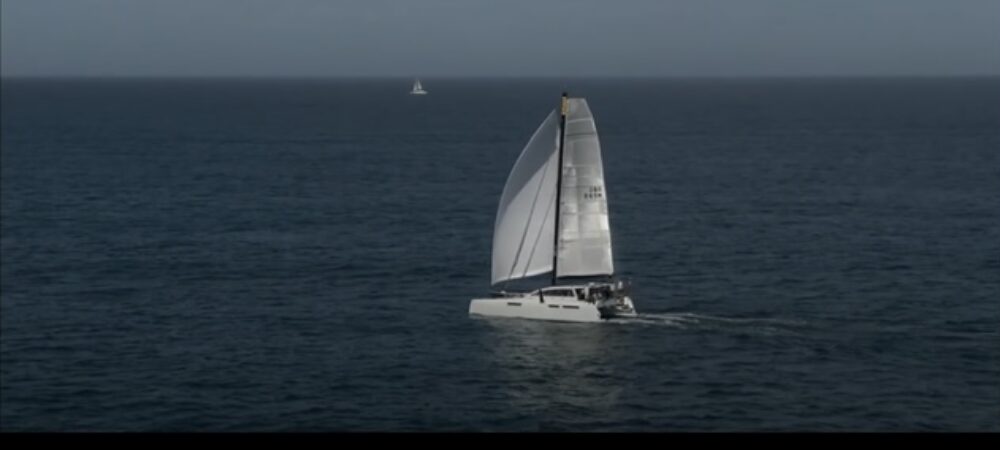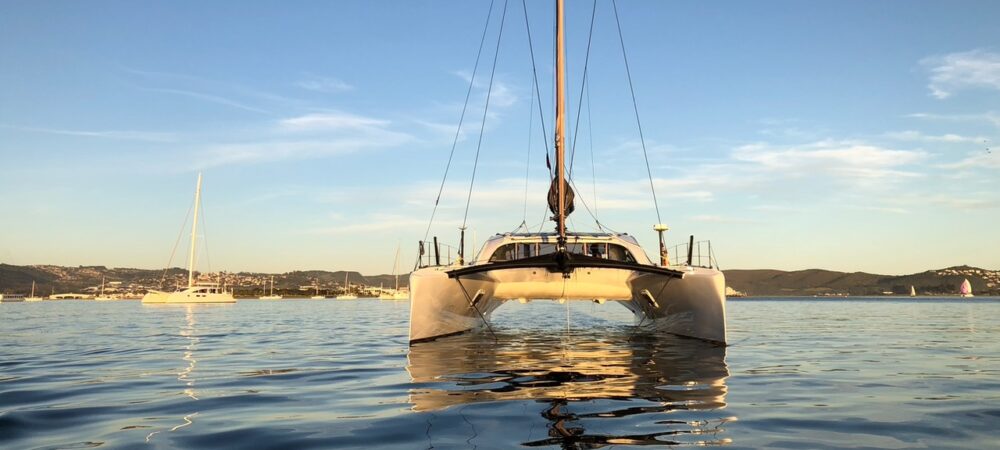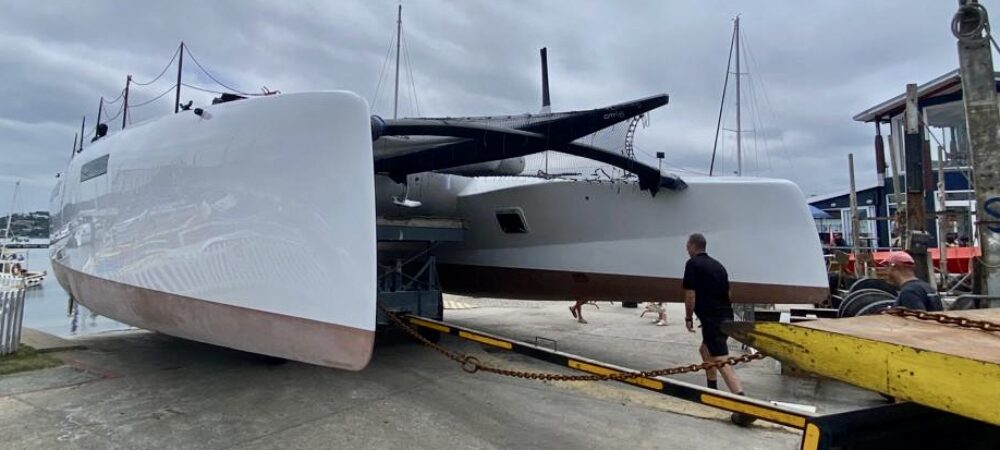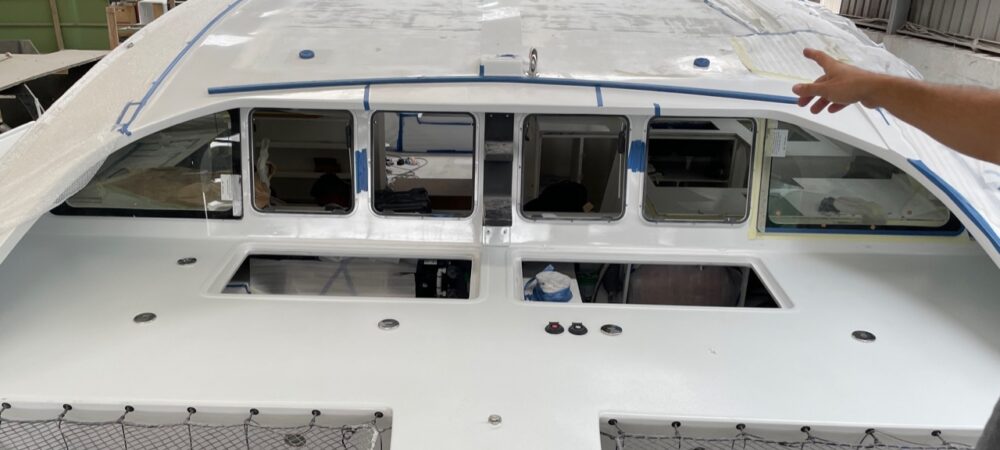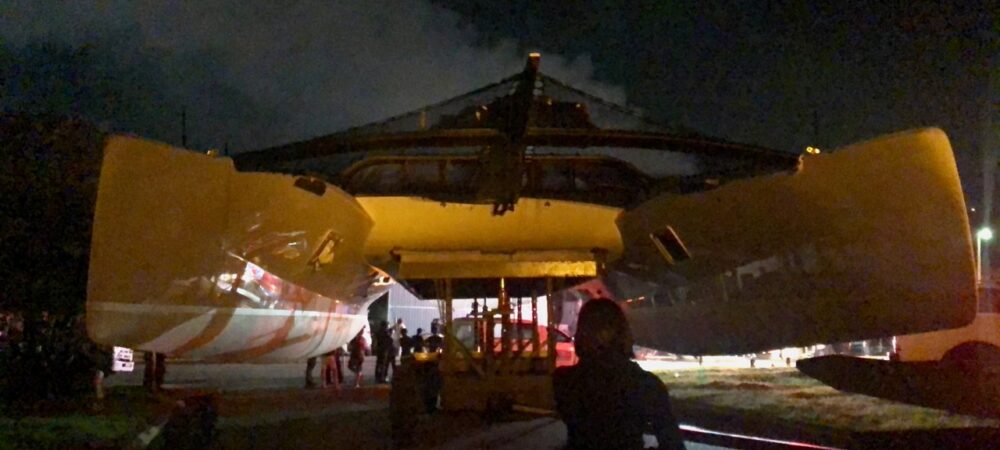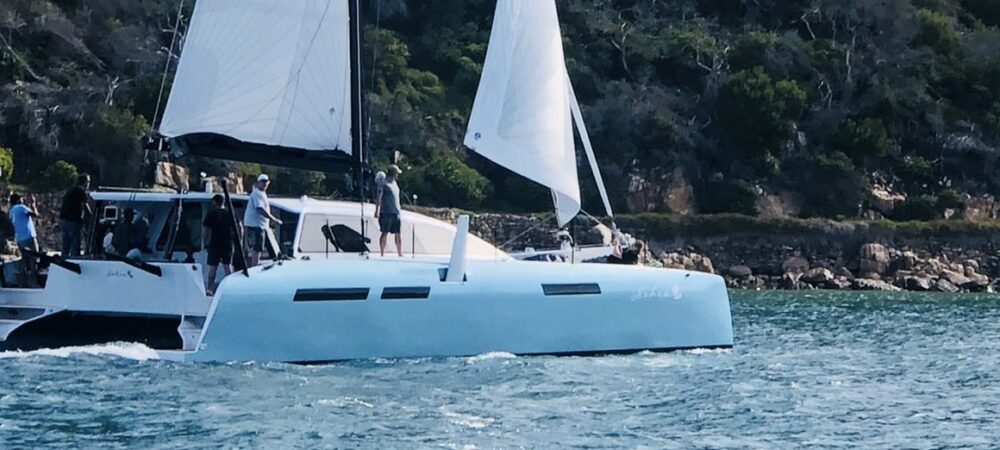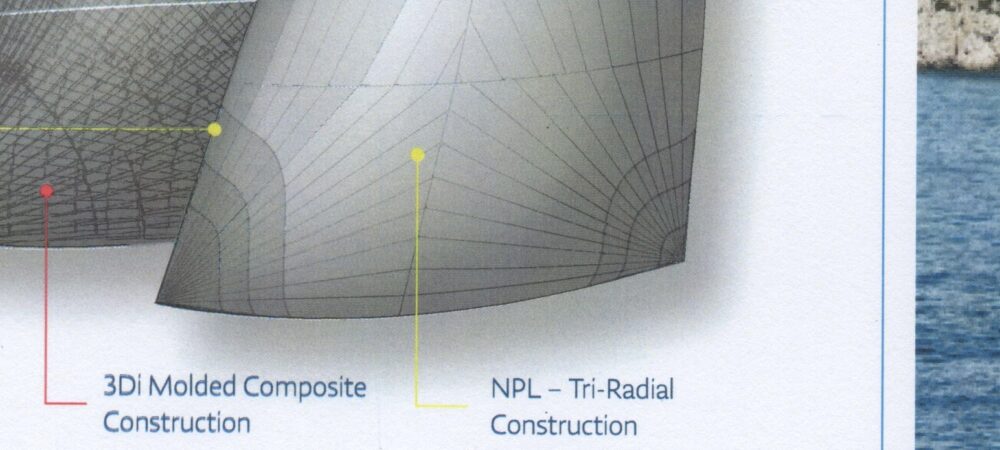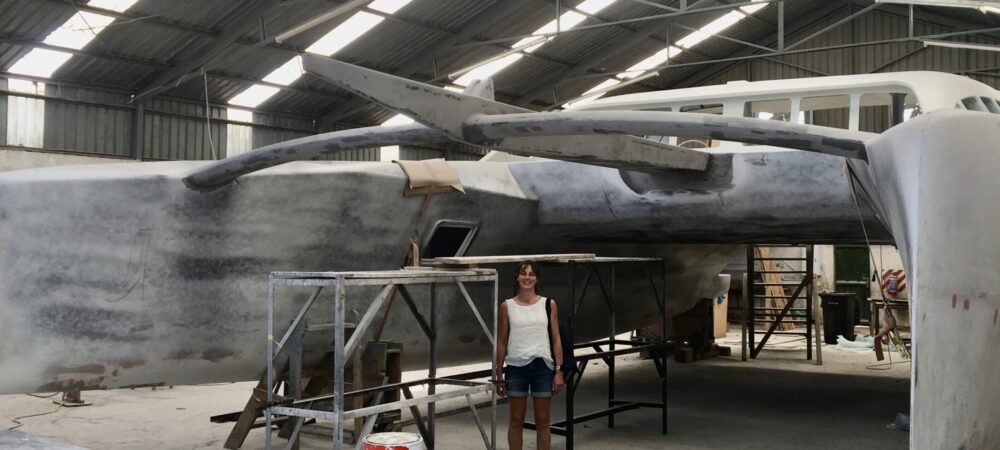Stunning
Maybe we shouldn’t be the ones to say it but… we just have to… Rush is stunning.
She looks fast, is fast, turns heads and is remarkably comfortable. Phew! And so exciting!!
Everyone wants to come sailing. Everyone that comes aboard (and, trust us, everyone wants to come aboard) says the same – the uncluttered layout and 360° visibility make Rush feel spacious, exceptionally spacious for a 46’ skinny, truly high performance cat.
Set-up and commissioning have been a process… Nearly there.
Anyway, all you really want are photos, so here they are:
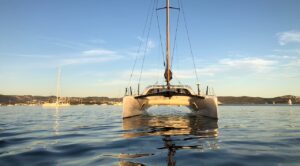
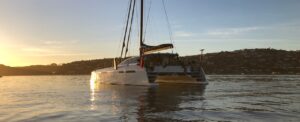
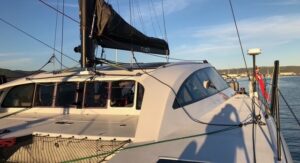
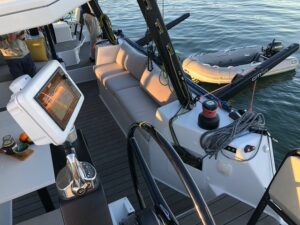
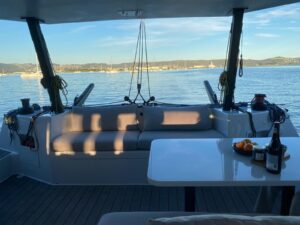
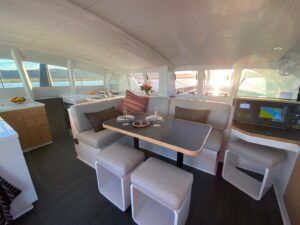
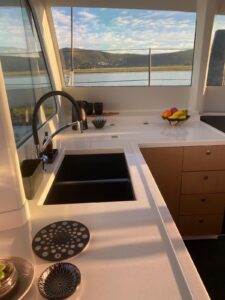
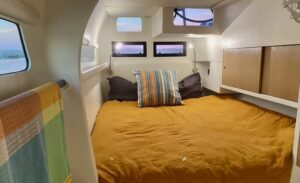

Launch!
Rush is afloat! She was launched on Tuesday 6th Feb.
All went smoothly and, despite the fact it was mid-day in the UK, we shared the moment with our great friends Justin and Polly in our conservatory at home; opened Champagne and toasted the good ship. Amanda cried.
Here are a few photos from the launch and soon after. Rush is no run-of-the-mill production boat. She looks fabulous and, once the rig, equipment and all the graphics have been added, we think she’ll be very special.
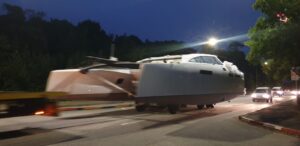

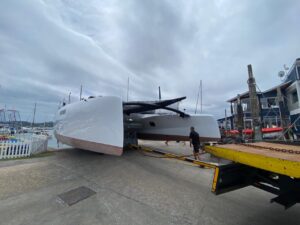
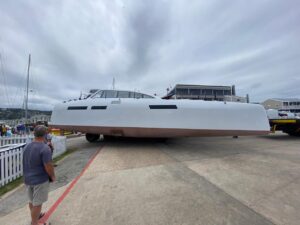


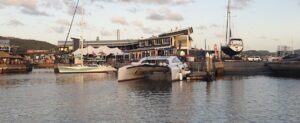
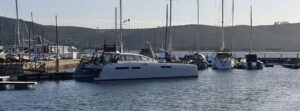
This was a true milestone for Julian, Renay, Rod, Adrian, Lindsay and the whole CM team (wish we could mention them all). A demonstration of perseverance and overcoming adversity. We truly appreciate it – thank you.
Build Update 5
Time to fire up the blog again – Rush is nearing completion!
She is on the launch trailer and the Coppercoat antifouling has been applied. You’ll see from the photo, Coppercoat was a choice of function over aesthetics… As mentioned in an earlier post, it should last for many years and can be regularly cleaned while the boat is afloat, without wearing it away – and it’s sustainable. Once in the water, the initial brown colour should soon change to a greeny black, making it slightly more on-brand with Rush’s colour scheme!

There are a few jobs remaining on the boat which are being ticked off at pace and, while the new mast requires a bit more work, it should be ready very soon.
The lithium batteries had been held up during freight but the ship was scheduled to dock in SA at the end of January so just customs clearance to be negotiated.
Launch is close. There will be a protective caution in our minds until Rush is afloat – and we’re on board with stiff rum and cokes in hand. That said, of course we’re excited.
We’ll soon head out to Knysna. Fortuitously, we’ll be in the UK long enough to also share a toast with our lovely friend Alison, who finally moves into her new home on February 2nd, after nearly two years of a bumpy ride. Perfect.
We’ve assembled a range of gear at home to take with us when we travel back to SA – some domestic items that we particularly like but are not available out there – lots more technical gear, such as Starlink and Iridium sat comms equipment. Packing everything, so we know how many bags to book onto the plane, has begun. Think we ‘re gonna need a bigger boat plane…!
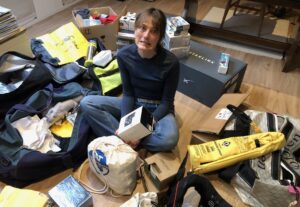
Once Rush is rigged and ready, we’ll spend several weeks based in Knysna and Cape Town while we learn, sail, de-bug and (cannot wait) bimble our new boat. For those whose first language is not Sailing English, that means splicing, tweaking line lengths, marking halyards and reef lines at clutch points, creating specific stowage places, etc etc etc. It never ends and, while it can be an enjoyable indulgence, it also makes the difference between a boat that works OK and a boat that works smoothly, hopefully every time. Most sailors, especially racing sailors, are on it.
Between them, Knysna and Cape Town are home to CM, Clarence the electronics guru, the Nanni engine distributor and most other SA marine equipment suppliers, so they’ll be great places to refine the boat as required and obtain the spares we want to carry when we head off.
The current plan, when we do set off, is to head up the Atlantic to the Mediterranean. This passage demands a circuitous route due to the North Atlantic trade winds that blow inconveniently the wrong way – from Europe, down the African coast, towards the equator.
First stop will be (a dot in the middle of the South Atlantic) St Helena island.
Then across to the Brazilian Fernando de Noronha islands, just off Brazil’s eastern tip.
From there, weather routing is likely to take us around the west side of the Azores high pressure system, to the Azores.
The final Atlantic leg will be to Gibraltar (perhaps via one or two ports on the Portuguese / Spanish Atlantic coasts).
Easy to write that route! How hard can it be???!!! We’ll let you know.
By the time we reach the Med, we and Rush will have covered some serious ocean miles.
Build Update 4
Well, this is an overdue update we never expected to post… and have put off for a long time.
Four months ago, as Rush was nearing completion, there was a fire in Current Marine’s factory… Our beautiful boat sustained some localised damage which was incredibly sad, but is fully repairable. She will be perfect again – although it will take some time.
The fire started one evening in the section of the factory used for manufacturing masts, booms, daggerboards and other carbon components, plus the stores and offices. The bigger part of the building (mainly separated by a wall) where there are four CMs in build was, fortunately, largely undamaged.
You couldn’t make it up really… Rush had been loaded onto the launch trailer a day earlier, ready for Coppercoating the next day and launching a week later. Mark, who runs the business that launches all the Knysna built cats, was nearby and fortuitously one of the first to spot the fire. He forced open the doors, hooked up his truck and towed Rush out of the factory. Seun Julian, another guy nearby, also went way above and beyond in helping get Rush out. THANK YOU, to you both.
Julian called us soon after and when we arrived Rush was sitting across the road, lit by flashing lights. That was the first time we’d seen Rush out in the open, not hemmed in by walls and boats in build. It was such a mixture. Amid the scene, she looked amazing.

One edge of the coach roof had been badly scorched and Julian decided to remove the cabin top and fit a new one. CM had a roof made for another boat so they used that. Luckily the interior was undamaged – not even effected by smoke because she was so quickly pulled out of the factory.
Most of the “loose” components (tables, stools, sliding door, antenna posts etc) that would have been slotted in just before launch were in the stores area and destroyed, so new items need to be built. CM also need to make us a new carbon mast and that requires making a new mould first.
As you’ll understand, the fire was tough for everyone. Us, of course, but far more so for Julian, Renay, Rod and the whole CM team. They’re remarkably resilient and are pushing on. The following morning Rush was moved to Knysna Yacht Company around the corner, who generously offered space so she could be kept away from the dust while CM’s factory was cleaned up. Composite work on the other CMs resumed within literally a few days.
We spent a few weeks in Knysna after the fire, hopefully giving a little moral support. The Knysna boatbuilding and yacht club communities were fantastic – supporting CM, heart-warmingly lovely to us. They were also unswervingly enthusiastic about how great Rush will be.
We headed home in May and arrived as the UK spring weather turned glorious, with our garden in full blossom and the summer ahead. It is good to be here, despite the circumstances. We’re very fortunate to have mates with boats who’ve invited us to sail with them and we’ve also stepped back into our racing life – including the Round the Island race, the RS21 National Championships, Dartmouth Sailing Week and even a Scow regatta on the Beaulieu River! The Baltic Yachts Rendezvous and RS21 Worlds (both in Sardinia) are coming up in September. We cannot complain.
In addition, Amanda’s passion for open water swimming has reached new heights. Looking for a new challenge she signed up for the Dart 10k – yes, that’s a 10km (10km!!!) swim down the River Dart, above Dartmouth in the UK’s West Country. She’s trained all summer from Lepe Beach, just down the lane from home, building up her distance steadily and, on 2nd September, smashed the big swim (2hours 48mins) with around 500 people from near and far (it’s a sort of London Marathon of swimming), raising a sack of cash along the way, thanks to many of you, for Level Water, a charity which enables disabled children to experience the pleasure and freedom of open water swimming. SO proud of my (our) Amanda.
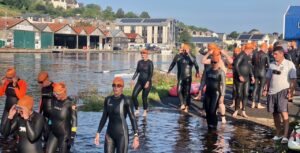

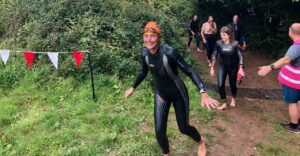
Meanwhile, as I write, back in SA the composite work on Rush has largely been completed, with the new roof fitted and fairing underway. It’s a bit of an upside as the roof design was updated after our boat was built and we’ll end up the latest styling.
CM are ramping up production and taking the opportunity to re-plan and increase factory space. The need for new mast and boom moulds also gives the opportunity to upgrade them and enable a production increase so, one way and another, they’re making the most of what was a shocker of a set-back.
Our blog will come alive again when Rush is ready once more!
Build Update 3
Quick update – Rush is nearing completion!
There are several key pieces of equipment that won’t arrive before mid January and we’ll head out in January to get under the skin of the systems, make a few last-minute cosmetic decisions and add the graphics before the boat is splashed.
The trailer used to transport the boat to the slipway will arrive at the yard a few days before launch and lift the boat under the bridge deck. Then the chocks can be removed giving clear access to the hulls for application of the Coppercoat – five coats in total, I believe.
The mast will be stepped after launch and we’ll get a hands-on understanding of the set-up. The plan is to do initial trials from Kynsna before sailing round to Cape Town where we’ll spend a period of shakedown sailing, living aboard and getting to know the boat. Key suppliers, such as North Sails (David Rae) and CYS (Clarence Hendricks) the electronics guru, are based in Cape Town so we’re hoping this will give a great opportunity for them to spend some time with us and we’ll learn a lot.
It all feels very real now. Counting down the weeks and not sure whether our pre-departure jobs list is getting shorter or longer…!
Solar System
If you’ve been thinking about a yacht installation, you’ll already know it has to deal with multiple issues, including:
- Shading from the rig
- Heat build-up
- Low light conditions
- Restricted space
- Curved surfaces
- Durability / walk on capability
- Weight
Solar technology is evolving and the solution arrived at with Julian is currently towards the leading edge, without getting into unproven territory.

MiPV Solar Panels
After investigating many solar panel technologies and brands we settled on CIGS (Copper Indium Gallium Selenide) thin film technology by a British manufacturer, MiPV (and, by the way, we didn’t get a special deal – this isn’t an ad!). The technology differs from conventional crystalline based solar photovoltaic systems and seems to have real advantages for yachts. Check their website https://mipvsolarpanels.co.uk for full details.
Perhaps the most useful thing I can add is an assessment of how these panels deal with the typical yacht installation issues:
Shading from the rig
Definitely one of the greatest challenges and it results in the output from many systems being dramatically below their theoretical maximum.
Solar panels comprise a grid of multiple cells and if a panel is built, for example, with just one diode per row of cells (a common configuration), when one cell is shaded the output from the whole row is cut off. Worse, if there is only one diode on the whole panel (not unheard of), then any shading shuts down the whole panel! Panels with multiple diodes are quite rare – and usually expensive.
The MiPV panels have a diode on every pair of cells so, if a panel is affected by shade, then only the output from the actually shaded cells is lost – the others keep working. This makes it possible to maximise the panel coverage on, for example, the roof – and just accept that some cells will get shaded. We’re not worried that some cells will be shaded by lines routed directly to the cockpit – it’s better to cover the roof with panels so that those losses are more than compensated elsewhere. If we’re anchored for a while and want to maximise the output, we can tidy lines away from the cells and swing the boom out to a shroud.

Heat build-up
It’s a huge irony that the output of most solar panels drops dramatically as they get hotter in the sun! Talk about Catch 22… The problem is particularly acute on cabin roof installations – davit mounted arrays fare better due to airflow underneath. There are ways to reduce the problem somewhat (eg. bonding panels onto hollow plastic sheets) but this adds weight and cost while impairing robustness.
CIGS thin film technology, however, is completely unaffected by temperature (within the range the solar panels will face) so their potential output remains at maximum. Major advantage.
Low light
The MiPV panel’s output curve rises significantly faster in lower light conditions than conventional panels so they produce more power at the ends of the day (which happen twice every day) and on cloudy days (which seem to happen more often than we’d like!).
Restricted space
The downside to the CIGS thin film technology is that the theoretical maximum output per square metre is lower than the most efficient conventional panels.
This, however, ignores the facts that their performance doesn’t decrease with heat and their output is better in low light. Overall, therefore, we believe the MiPV panels will score well, even though the theoretical max output figure for an array area will appear lower than some.
MiPV manufacture the panels to order, with a choice of three widths (358mm/3 cells – 674mm/6 cells – 990mm/9 cells) and almost any length.
It’s therefore possible to tailor the array to maximise the space available and to suit desired cable run locations.
Curved roof capability
These thin film panels are genuinely flexible – in fact they’re supplied rolled! So there’s is no problem fitting them on a curved surface, such as the flowing line of the CM’s roof although the curve, of course, can only be in one plane.
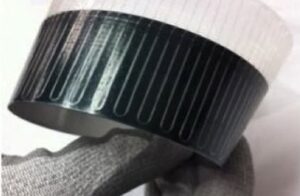
Durability
CIGS thin film technology has no glass in the construction, unlike crystalline semi-flexible panels which surprisingly (to me anyway) have a thin glass layer. That’s why they tend to break down over time (even during transportation and installation if not handled carefully), lose efficiency, often have a relatively short warranty period and most can’t be walked on.
MiPV panel durability means they have a 25 year / 80% output warranty and it’s perfectly OK to walk on them. That’s a big deal in maintaining ongoing output, coupled with elimination of the cost and hassle of replacing them.
Weight
The panels weigh about 3kg/m2, so they’re very light and thin compared to most. If you’re going to create a truly light boat it’s essential to focus on weight in every aspect of the build and fit-out, as CM do.
MPPT charge controllers and cabling
A smart MPPT harvests the energy from solar panels efficiently and routes it to the boat’s battery bank. Our system will use Victron SmartSolar charge controller MPPTs, matching most of our electrical components. If weight, cost and cabling were no object, then you’d connect each panel to an individual MPPT charge controller. It’s normal, however, to balance those three factors and connect two or three panels, often more, into one MPPT – we’ll have six panels and three MPPTs.
BUT – and here’s something that’s easy to overlook – if you connect different size/output panels (or panels that get shaded differently – eg on either side of the boat) into one MPPT, then you reduce the output dramatically. In the case of different size panels, you may even reduce the output of each panel to less than that of the smallest one! It’s important to design the panel layout with this in mind – connect equal size panels – connect panels from the same part of the array.
The wide variety of MiPV panel sizes helped make it possible to design an effective layout, taking into account the above restrictions.
Installation size and location
Our original plan was to install panels on the cabin roof and over the davits but, since choosing the MiPV system, we’ve decided not to fit the davits array. We’ll save weight at the aft end of the boat and maintain an unobstructed view.
The CM’s roof will comfortably fit a 2kW array which, bearing in mind the panel’s shading and low light efficiencies should, we reckon, be ideal for our systems. The Watt & Sea will add hydrogeneration when we’re sailing, so we’ll have more than enough power underway. If there does prove to be a shortfall at anchor we could add a couple more “roving” MiPV panels clipped onto, say, the trampolines – and stow them rolled up on passage.
Cost
Despite all the apparent advantages of the MiPV panels, they’re competitively priced – OK, more expensive than the cheapest rigid or semi flexible panels – but less than most high quality options.
Aesthetics
And finally… they have a smart all-black appearance!
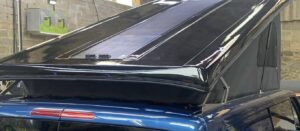
Build Update 2
Whoa… The header photo is CM46 #3, not our boat.
Our boat is now in the latter stages of build so it’s a good time for an update – on Rush and the other CM46s launched.
It’s worth explaining that, during the time we agreed for CM to take some moulds from our boat (mentioned in a previous post) CM46 #3 overtook ours in the build process. It was then best for the fit-out team to focus on #3 before cracking on with our boat, rather than juggle both. We understood this and must admit, with apologies to Mike the owner of #3, we thought there were bound to be a few new ideas sparked by another boat launched. We will, of course, mercilessly point out every tiny improvement to him while he’s sipping pina coladas in the Caribbean… and we’re still in the shed…
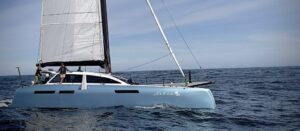
As I write, Nohea is in Cape Town with final jobs and provisioning being completed ready for the delivery trip to the British Virgin Islands. She looks stunning. I do hope Julian and the CM team are feeling proud.
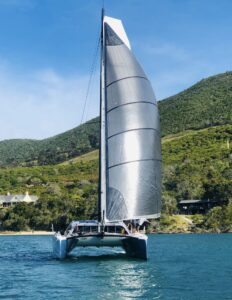
During the trip from Knysna to Cape Town Nohea sailed, with full main and Code 65, at 11 kts boat-speed in 10 kts of breeze. Those kind of speeds often make it possible to choose the loveliest sea conditions and still make excellent progress. Now that’s what we want.
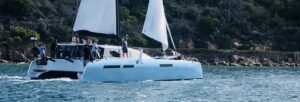

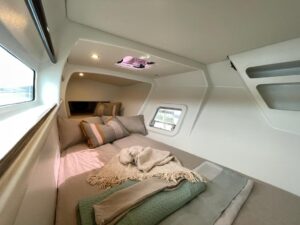
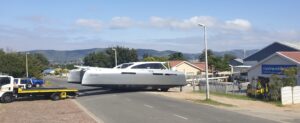
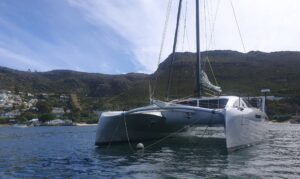
CM46 #1, Levity, recently reported 22 kts boat-speed in 19 kts of breeze off Auckland, with one reef in the main and self-tacking jib. I also spotted these comments by Jason Ruger (Gypsy Yacht Deliveries) who sailed Levity half-way around the world, from Cape Town to Auckland via the Panama Canal. Hope he doesn’t mind me repeating them here:
“I’m so in love with this boat”
“… this boat is going to take the world by storm!”
“Thank you for building her so strong!” (They hit a whale mid-way across the Pacific – fortunately it appeared, giving it nothing worse than a major headache)
This is all good confidence-boosting affirmation for us to see and hear!
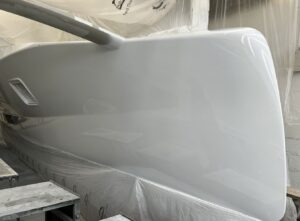
Anyway, getting back to Rush – here are a few photos taken when the exterior was sprayed. Check out that finish. Everything you can see on the hull is reflection… Terrifying! We might order more and bigger fenders.
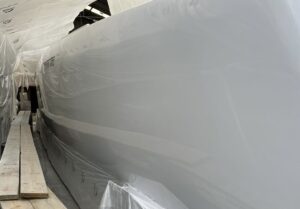
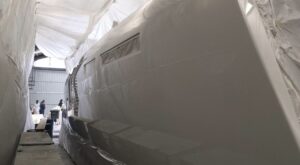
For the interested nargs, the colour we chose is Awlgrip Chevy White (basically a very light grey) – same colour over the hull, deck and cabin-top. We want a light colour to keep the boat as cool as possible inside and, while Levity and Nohea’s metallic paint jobs look pretty awesome, we’re going for an easier to touch up finish… just in case! All the composite “components” are sprayed in satin black – spars, longeron, forward cross-beam, davits, bimini pillars, pedestals etc.
Fit-out is likely to be completed ready for launch before Christmas and our plan is to head out to Knysna to see the final stages come together and understand everything behind the scenes as best we can. Then launch and start the next phase of the adventure.
Sail Choice
CM’s supplier of choice is the North Sails loft in Cape Town and we’re very happy with that option. North need no introduction and a local loft is likely to be an advantage as the wide range of options means that each CM rig will, to some extent, be a prototype – the odd tweak may be needed after trials – a process that’s not new to me! That said, North in CT made and tested the sails on the first CM46, so they have a head start.
Fabric: Mainsail – Solent – Staysail
We gave a lot of thought to our choice of sailcloth – trying to balance all the pros and cons. We’ve opted for North’s NPL Tour Xi. It seems a good compromise between 3Di (which probably offers the best combination of shape stability, light weight and durability… but is expensive) and a woven cloth (which is durable but heavy and lacks shape-stability). We had Hydranet woven sails on the Pogo and they were bullet-proof so we’d have liked to go that way, but they were heavy and began to loose shape after a few years – not unreasonable considering the 10,000 miles under the keel. Having opted for a carbon mast and textile rigging on the new boat, however, it doesn’t seem logical to use heavy sails. Catamaran rig loads are higher than monohull’s so, particularly on a cat with real performance potential, low stretch sailcloth is even more important to maintain shape, speed and pointing ability, especially as the sail ages.
North’s Tour Xi fabric achieves its stability through a laminate of mylar with aramid fibres, sandwiched between polyester taffeta on both sides for durability and UV protection. Lamination processes have improved significantly in recent years and North have confidence in the durability of this fabric, which they promise is well-proven, so we’re embracing this advice!
https://www.northsails.com/sailing/en/sails/materials/npl/tour
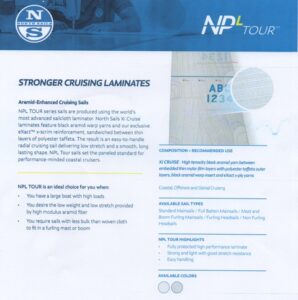
Mainsail
The main will have a biggish square head, approximately 40% of the foot length. Square heads improve the efficiency at the top of the rig. Hard to sum it up in a sentence (I’m not a sailmaker) but basically you get better airflow because there’s more sail working beyond the turbulent area behind the mast (the top of a pinhead sail is largely in turbulent flow, especially on a non-rotating mast) and a properly designed square head helps the leech twist open in gusts, de-powering/reducing heeling moment automatically, powering up again as the gust eases.
The boom is low above the cabin roof to minimise the height of the Centre of Effort and maximise boat stability and efficiency. The low boom is possible because sail controls are at side deck level (keeping our heads below the parapet) – and there’s no need for boom clearance over high helm spray hoods because the CM’s wheels can be swung down under the roof for shelter.
The main will have the usual three reefs and, less commonly, leech reef hooks. They’re popular on offshore race-boats but the hooks are expensive and they’re less common for cruising. Have a look here to see how a reef hook operates if you’re not familiar – fundamentally the leech reef line is winched in as normal until the hook (attached to the boom) engages onto a Dyneema loop on the leech and takes over the load. All the chafe and stretch associated with the reef line is eliminated. The hooks can be disengaged remotely by a release line.
Julian recommends leading only the 2nd and 3rd reefs back to the cockpit (they can also be operated at the mast), to minimise line congestion. The 1st reef will be led to the mast winch only as it will be used when the conditions aren’t severe. We can always go straight to the 2nd reef from comfort of the cockpit if the wind builds fast or one of us is alone on watch.
Solent Jib
Not sure whether the name “Solent” is widely used with cat sails (funnily enough, it seems to have originated in France) but it describes a genoa which overlaps the mast by a small amount – circa 110% of foretriangle J measurement. Anyway, we’ve opted for a Solent because the advantage over a self-tacking jib (sheeted in front of the mast) is that it adds area low down – which lowers the CoE and the overlap helps build the slot effect between the headsail and mainsail, particularly in light winds. This improves power and upwind performance. The downside is that we won’t be able to tack while holding a mug of tea – we will have to wind a sheet!
The Solent will set on a structural furler on the forestay and have four vertical leech battens to enable a small amount of roach – helping the slot effect further. It will sheet through 3D leads – low friction rings with inhaul / outhaul controls – on either side of the cabin top which are lighter and more adjustable than tracks.
In normal circumstances we’ll only use the Solent fully unfurled – and change down to the staysail when we want to reduce area. As normal, a UV strip on the leech and foot will help protect the sail from the sun when furled and, hearing how aggressive the degradation can be in the tropics, I think we’ll also get one of those zipped tube covers that we can hoist over the furled sail when moored.
Staysail
Our Rig blog post describes why the staysail is such an important part of the rig and we foresee this sail being used a lot on our boat – upwind as soon as the breeze is into the mid teens and, potentially, when reaching with the Code sail in light airs.
We’ve specified a torsion cable luff and continuous line furler so the sail will be hoisted furled (no flogging) and tensioned by a purchase at the tack, led to the mast winch. It won’t need a separate stay. It can be hoisted and left ready to go on passages where conditions are changeable – or it can be dropped onto the trampoline to open the foretriangle and allow easy short-tacking with the Solent.
The staysail will sheet to a self-tacking track on the cabin top, just forward of the mast – easy manoeuvres, with tea, in breeze. It’ll have UV strips.
Storm jib
We’ll need a small, tough, woven cloth sail – also with a torsion cable luff so that it can be set using the same furler, halyard and self-tacking sheet track as the staysail.
Offwind Sails
There are many options for the off-wind sail wardrobe with our goal, in common with most cruising sailors I guess, being to effectively cover all angles using the minimum number of sails. Fewer sails mean fewer sail changes, lower cost, less weight and more space in the locker! I suppose increased redundancy would be an upside of a wider wardrobe.
These are our choices to, hopefully, best suit the boat and our sailing:
Code 65
North offers the choice of three Code sail designs – Code 0, Code 65 and Code 55. They are progressively narrower at half height and flatter cut for higher wind angles.
The CM will be fast, so will quickly pull the apparent wind forward and this leads to going smaller and flatter than a Code 0. Equally, as we’ll have the Solent (rather than a self-tacking blade jib) we’ll have less need to use a Code sail upwind, which would otherwise have steered the choice to a Code 55. The Code 65, therefore, should be the most versatile option within our set-up – to be used as soon as we put the bow down (in under 15 knots), until the apparent wind is just behind the beam.
The Code 65 will use North’s Xi Code T fabric (Mylar, Aramid fibres and single polyester taffeta outer ply) and have their Helix luff design. This relatively recent design development shares the luff load between a lighter torsion cable and the sail itself. It’s a great evolution, requires less luff tension and creates a more versatile sail with increased luff projection.
It will be set from the forward end of the longeron on another continuous line furler – tensioned by a tack purchase, in exactly the same way as the staysail.
We’ll also have UV strips on the leech and foot of this sail to maximise protection when the sail is up and furled, but we should take it down if it’s not likely to be used again soon. It could be stowed in a long bag on the trampoline underway, still connected and ready to re-hoist.
https://www.northsails.com/sailing/en/downwind-sail

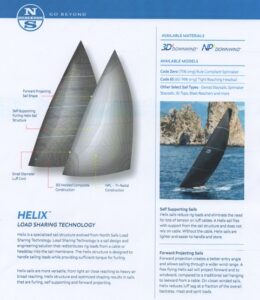
G1 Gennaker
This sail overlaps slightly with the deepest angles possible with the Code 65 so in very light winds we’d choose the G1 for more power. The G1 will also have a Helix structured luff and North sound very enthusiastic about the versatility (wide range of wind angles) that the Helix luff allows this sail to cover. The extra luff projection helps the sail continue working to deeper angles and this extends further if you ease the halyard as you go deep. It will even be possible to pull the tack over to the windward bow and go down to around 160T, although I think only experience will tell us whether that’s preferable to sailing higher, pulling the apparent wind forward and going faster.
The G1 will share the furler with the Code 65 and we gather the Helix design makes furling much easier, with less luff tension required and less chance of the sail wrapping. We’re also told that, as long as we can apply reasonable luff tension, it will even be possible to furl the sail with the tack pulled across to the windward bow.

Symmetrical Runner
So, that just leaves the question of dead running on long tradewind legs… The CM will generally efficiently VMG to the destination by heading up, bringing the apparent wind forward and sailing the angles at greater speed. But (from endless vlog watching and other equally scientific research) we envisage legs when dropping the main and running on the rhumb line at lower speed would be a relaxing and easy way to go, especially if it meant the waves would be directly behind. In this mode an intrinsically light, quick boat will still benefit from its ability to attain decent boat speeds from the resulting low apparent wind speeds, surfing when the conditions are right.
In over 25 knots we may have enough horsepower by running with the Solent and staysail goose-winged – with barber haulers to stabilise them. So perhaps the window for an extra running sail is small. We haven’t finalised this call yet… Another sail, another mode decision, added expense… Or, on the other hand, the go-to set up on tradewind legs with the bonus of added redundancy…??
We need to decide soon whether to add an extra sail – and, if so, there are two options. The obvious one is a smallish symmetrical spinnaker with a sock. The other option, possibly un-cool on a rocket-ship cat, is a Tradewind sail (North’s name – also known as a Bluewater Runner by Elvstrom). Basically, two light genoas, joined at the luff, furled together. They can be set goose-winged or one side of the sail can be gybed onto the other (like a 2-ply genoa) to halve the area – perfect in a squall or to reach at higher angles. This mode would add some redundancy if the Code 65 were damaged. Poles aren’t needed for either of these options, due to the catamaran’s beam. Big handling win.
If a Tradewind sail could be big enough, without becoming unstable, to achieve the same performance as a small symmetrical spinnaker, it seems to offer a number of benefits. I need to pluck up courage and discuss it with the purist experts!
I’ll add an addendum to this post to let you know the outcome.
Build Update 1
I’ve been chased for more info about the build of our boat, so apologies for being slow – here’s an update and photos from earlier in the year when we visited!
(Also see Travels section post)
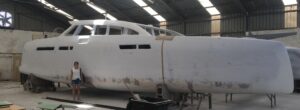
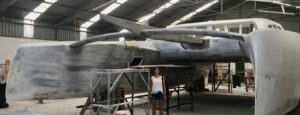
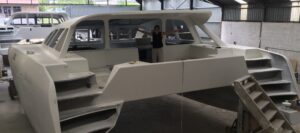
Back in February the composite work was largely complete; the hulls had been post-cured and faired and the interior structure was about 90% done. The topsides are beautiful and quite curved, so represent a time-consuming element of the build process and we agreed, last year, for Julian to take moulds from the topsides of our boat in order to improve the time-efficiency of this part of future CM46 builds. This, of course, delayed our boat but I guess I have plenty of empathy with the whole productionising, scaling-up and boat-building process, so was a soft touch when he asked.
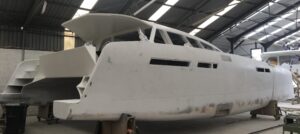
Having been unable to visit South Africa until early this year due to travel restrictions, the timing of our trip actually proved perfect to give us a great feel for the boat, the layout and spaces above and below decks.
Have to say, we were blown away by the quality of the composite work and the overall look and feel of the boat. Aesthetics are subjective but we think the boat already looks AMAZING and will only get better when finished and fitted. The spaces feel plenty big enough – actually bigger than we’d expected or remembered from our original visit when we looked at the shell of 46 #1. Maybe some areas will appear to shrink a little after fit-out when tables, doors and other items are installed but we were very happy (and a little relieved) with the saloon and cockpit layout that we helped develop – especially as it’s now the standard layout. It’s much easier to envisage it all when standing on the boat than it was locked-down in our home loft office, with a lap-top screen, paper, rule and calculator!
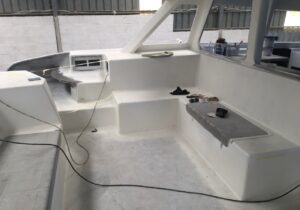
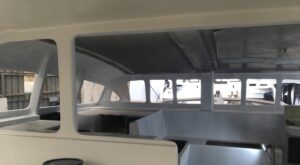
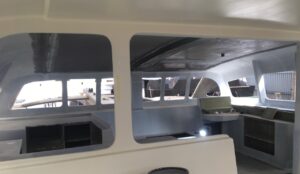
While at Current Marine we finalised many remaining details with Julian and the CM team – from deck layout elements such as exact helm seat and winch locations to suit our reach, right down to our planned usage of lockers and resulting desired internal shelf spacing, etc, etc. Our mates will be amused (but not surprised) to hear we specifically went to a liquor store to check the average height of a rum bottle.
The furniture is all foam cored composite, fully laminated into the hull before being faired and finally painted. It contributes to the structure, is super-light and won’t creak. Locker doors are also foam cored composite panels and they were away at the veneer specialist, being laminated with our chosen oak finish.
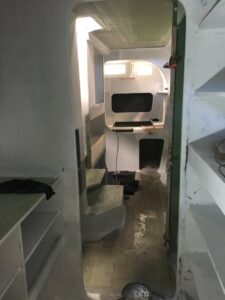
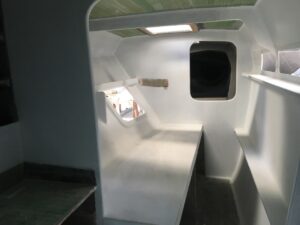
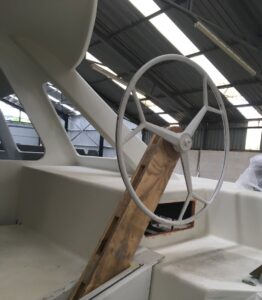
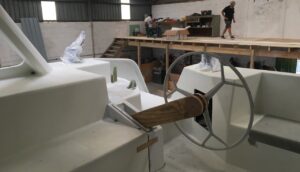
The last couple of years have been a challenging and full-on period for Current Marine. In addition to the obstacles presented by Covid they have also literally worked around their factory being doubled in size to accommodate more boats in build. Construction was in the latter stages while we were there and, unexplainably gratifyingly, even the factory builder proudly told us he’d shipped a 36’ steel hull from France and was fitting it out at home before heading off cruising in a few years time! The CM team has grown significantly, now including a mix of experienced people who’ve worked with Julian for years and new members coming from other high-level production backgrounds.
Electronics and electrical systems will be installed by Clarence Hendricks of CYS, based in Cape Town, and we were able to spend an afternoon on the boat with Clarence and his son looking at everything from nav station layout and MFD locations, to domestic 220v socket positions. Clarence is also widely experienced – cruising his own boat and racing offshore as bowman (flippin’ handy for any skipper to find a bowman who happens to be an electronics expert as well!) around the South Atlantic and in Asia. Clarence has now also liaised with Sertec (the CMCE lightining protection manufacturer) and Ocean Data Systems (the UpSideUp manufacturer) before installing those systems.
Julian introduced us to the cushions supplier, located just up the road from CM in Knysna so we could talk through our design preferences and we created a spreadsheet to document it all once home. Our steadfastly simple boat needs thirty separate bed and seat cushions… and that’s before we get to scatter cushions…!
Final stop, before flying home, was to meet David Rae at North Sails in Cape Town to discuss all the options. I’ll create a separate blog post about our sails and set-up.
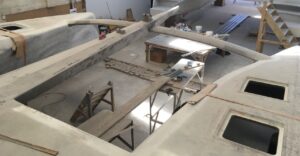
After much analysis, we’ve decided to use Coppercoat antifouling and, as it’s British made, I bought it direct. Provided it is applied correctly (it’s epoxy based so will be straightforward for CM) and well-finished by flatting back to smooth it and activate (expose) the copper, it should be effective. Coppercoat’s particular benefit is that it lasts for years so the annual, expensive antifoul application chore is eliminated. An added major bonus on our boat will be that the skinny, shallow hulls mean we’ll be able to easily wipe them from the dinghy or when swimming to minimise the hassle and cost of lifting out. The ability to regularly clean the boat, without the angst of rubbing off soft antifoul paint (hastening the need for re-coating), will be great. Coppercoat is more expensive but the lifespan and reduced haul out costs should more than compensate.
We’ve shipped the Coppercoat to South Africa with loads of other equipment for the boat. From egg cups up to Derek the dinghy and everything in between, we loaded a 20’ container in the farmyard next to home last week and it’s now en-route to Cape Town. We’ve worked with PSP Freight in the UK to organise the freight and Pronto Clearing will handle the import in Cape Town. There is a load of empty space in the container but it allowed us to use all the equipment we already own and was the most cost efficient option.
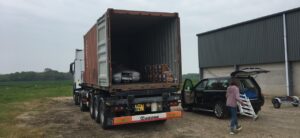
As I write this, the composite work on the boat has fundamentally been completed (I guess there will always be something to add or change until we actually sail away), the interior has been painted and equipment is being dry-fitted before removal for a final finishing paint coat. The exterior of the hull has been primed and will shortly be sprayed with Awlgrip top coat. We’ve chosen to have many of the ancillary composite components (davits, bimini pillars, stanchions, pedestals, table legs etc) in satin black to match the spars, longeron and forward beam and these are soon to be finished in a specialist local spray-booth.
We enjoyed our time in SA in February so much that we’re tempted to head over again before the boat is finished – the excuse being it would be great to see the various systems during installation and have the best possible understanding of them once we’re off cruising. We’d love to take the chance to travel around some other places over there and a wine expert, TV and newspaper critic friend from home has promised to set-up one or two vineyard visits with her contacts. We’re not at all sophisticated on that front and had better brush up our knowledge first – so an Aslina Chardonnay from the Western Cape is chilling at the moment!
End of content
No more pages to load

